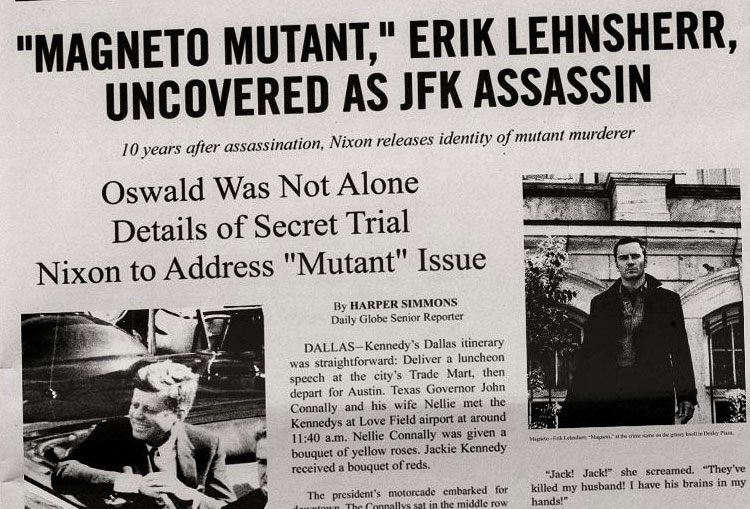

To understand Lehnsherr's motives — or, rather, the motives the Warren Report alleged he had — one must understand the era in which the Kennedy assassination occurred.
When Kennedy took office in 1961, the civil rights movement had captured national attention and political allies ... and powerful enemies, especially in the South. The X-Gene and mutants were not yet a part of the public consciousness, though they would soon become so, due in large part to Lehnsherr's activities.
The world was 15 years into the Cold War. Tensions between the U.S. and the Soviet Union were at a breaking point. By October 1962, the Cuban Missile Crisis was unfolding, and the world faced imminent nuclear war. Last year, the CIA and the Homeland Mutant Response Division released previously-classified documents stating the crisis was in fact orchestrated by a mutant and former Nazi named Sebastian Shaw. His goal was the extermination of homo sapiens worldwide.
Also declassified was the revelation that the Cuban Missile Crisis was thwarted by a clandestine CIA team called "Division X." Division X was comprised of several mutants led by Charles Xavier. Lehnsherr was also a member. His mastery of magnetism proved invaluable during the operation.
After the confrontation, Lehnsherr immediately left the team. He and other Division X members founded the Brotherhood of Mutants, an organization the FBI would quickly classify as "a pro-mutant terrorist group." Division X disbanded days later. All evidence of its existence was sealed by the CIA.
While the outcome of the crisis was widely considered a victory for the Kennedy administration, it didn't last. By early 1963, rumors swirled around the event as U.S. and Soviet witnesses to the Oct. 28 confrontation — nearly all of whom were naval officers — shared their unusual experience with other military personnel, civilians and even the media.
"It was a different time," explains "Scary" Carey Morrison, a veteran radio personality. Morrison has hosted the conspiracy theory show What If...? since 1977. "Back then, if you talked about folks with superpowers, you might as well be talking about little green moon men. Most didn't believe."
A few citizens in 1963 did believe, however, and leveraged the fear and uncertainty to advance their own agendas. One such influential provocateur lived in Dallas.
Edwin Partridge was a former U.S. Army Major General who had close relations with radical right-wing groups. He was an outspoken critic of Kennedy, an anti-Communist and a staunch segregationist.
Despite having resigned from the Army in 1961, Partridge's ties to the military remained strong. According to 1963 investigations by CIA task force Project: WideAwake, Partridge likely obtained “actionable evidence" from his contacts, confirming mutant involvement in the Cuban Missile Crisis. This material likely included amateur photos and 8mm footage shot from the deck of the USS Fiske.
Partridge soon alluded to mutants in his Dallas speeches.
"I'm calling for a national protest against the conspiracy from within," Partridge proclaimed during a rally in January 1963. ""We are a nation in dire peril, facing calamities on all sides. Communism. Our anti-Christ, anti-prayer Supreme Court. Others. And now, I hear whispers about a new threat: abominations among us, more dangerous than any nuclear weapon."
These materials and comments likely made Gen. Partridge an assassination target. According to the Warren Commission, Lehnsherr recruited political dissident Lee Harvey Oswald in February 1963 to kill Partridge. Oswald was a former Marine-turned-Marxist. The 24-year-old had defected to the Soviet Union in 1959, but returned to the U.S. a few years later.
On April 10, as Partridge worked at his dining room desk, Oswald aimed his rifle — a Carcano Model 91/38 he’d ordered from a mail catalog — from a sniping position less than 100 feet away. Partridge died instantly from the headshot.
Partridge's death incensed his supporters. This contributed to what Christopher S. Byrne, a retired Dallas Herald crime reporter, calls a "perfect storm of anti-Kennedy and unwitting anti-mutant sentiment" that saturated Dallas throughout that summer.
Indeed, mutant historians now call 1963 America's "Summer of Hate." Several mutants across the country were killed that year, including two members of Lehnsherr’s Brotherhood of Mutants. Azazel and Tempest were slain by Project: WideAwake operatives in July. Records state the mutant duo ambushed the operatives.
By the time Kennedy, his wife Jackie and Vice-President Lyndon Johnson landed in Dallas on Nov. 22, radical organizations such as the newly-formed Friends of Humanity had published flyers and newspaper ads accusing Kennedy of treason. One flyer said Kennedy “tells fantastic LIES to the American people, especially regarding the UNHOLY GENETIC HORRORS who have INFILTRATED our cities."
Kennedy reportedly saw these materials and remarked to his wife, "We're really in nut country now."
The messages were extreme, but impossible to ignore. Political analysts of the era agreed that the Kennedy administration’s next move should be to deliver a public statement regarding these genetic-related rumors. In fact, Nov. 22’s speech would have addressed these issues, however discreetly. It was never delivered.